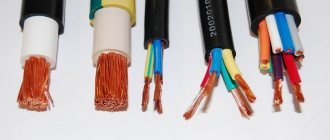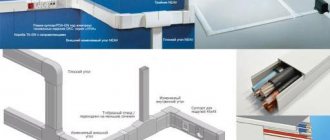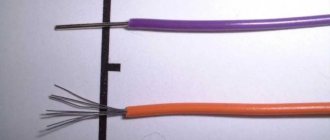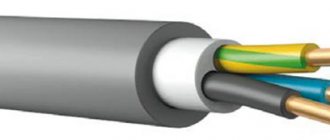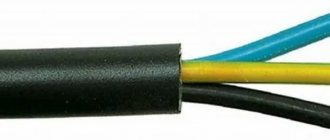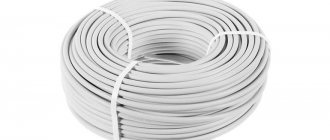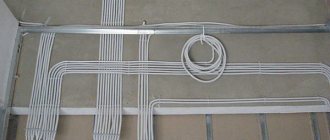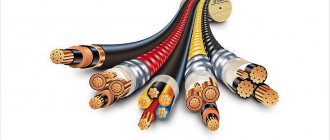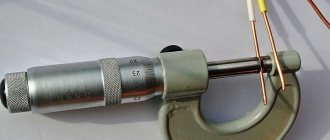There are often cases when amateur or professional electricians try to figure out which is better - stranded or single-core wire. It is categorically wrong to compare cable products of these types, and if anyone tries to do this, he once again confirms his incompetence. It's like comparing sewing thread and fishing line, which are used in completely different situations and are suitable for achieving unequal purposes.
When choosing a wire category, you need to focus on two main components - location and operating conditions. Our article will discuss the design features, differences and technical and operational characteristics of both types of cable, and will provide areas of application.
Differences
Five of them can be distinguished:
- number of conductors
- number of insulation layers
- quality of insulation and conditions of its use
- digital and letter markings
- lifetime
Let's take a closer look at how they differ and how they are similar?
Cable cross-section
The selection of wiring for a wooden house or apartment is made from those available with copper conductors, with a minimum cross-section of 1.5 mm². It characterizes throughput. For such elements, 1 mm² transmits 8-10 A, and for aluminum ones - only 5 A. The calculation of electrical wiring lines in a private house or other building is carried out separately according to the load, after which the cable cross-section is selected.
The table shows the cross-sections used for home electrical wiring (VVGng-LS cable).
| Purpose | Section, mm² | Maximum power, kW | Recommended rating of the protective circuit breaker, A |
| Lighting | 3x1.5 | 4,1 | 10 |
| Sockets | 3x2.5 | 5,9 | 16 |
| For electric stove or hob | 3x6 | 10,1 | 32 |
Designation according to GOST
First, let's decide on a name.
According to GOST 15845-80, this is what is meant by these cable products:
What is a wire? A wire is a conductor (solid or stranded) with insulation around the core in the shape of a tube. Some wires have no insulation at all.
For example, bare wires A (aluminum), AC (aluminum with a steel core), PS (steel wire), PSO (single-core steel wire).
A separate category is a relatively new type of wire - SIP (self-supporting insulated wire).
You can read in great detail about its characteristics, brands and differences in the article below.
A cable is already several insulated conductors connected into one structure. The cables have a double layer of insulation.
The insulation of the conductor itself, plus the insulation on top of all the cores. The second insulation can be from:
- place class=”aligncenter” width=”500″ height=”244″[/img]
- rubber or caoutchouc
- metal
- XLPE – cross-linked polyethylene
The most modern brands are cables made of cross-linked polyethylene.
That is, roughly speaking, it turns out that a cable is several wires combined under one protective sheath. If there is no more insulation on 2 or 3 conductors, even twisted together, then this is a wire.
Preliminary parameters of our electrical network
In order to decide which cable to use for wiring in an apartment, we first need to decide on a number of parameters. First of all, you should choose the wiring installation method, you should also determine the number of cable cores, the parameters of the rooms in which installation is to be installed, the number of wires laid together, and some other aspects.
Wiring method
At the moment, there are two main types of wiring installation. This is a hidden and open installation.
Each of them has its own advantages and disadvantages, and preference can be given to one of them only after detailed consideration. In addition to your preferences in the choice, PUE standards regarding electrical and fire safety conditions play an important role.
Selecting a wiring method
- Open wiring is quite easy to install, has good maintainability and is relatively quick to install. At the same time, it spoils the design of the rooms, takes away our free space and requires additional boxes or pipes for mechanical protection.
- Although, on the other hand, according to 2.1.2 and 2.1.3 PUE, the requirements for open wiring when installing on combustible structures are not so stringent in many respects. Due to this, this type of installation is chosen for installation on wooden and other combustible structures.
- Wiring the electrical cable in an apartment in a hidden way allows you to hide all utility networks and does not require additional protection when installed on fireproof structures. At the same time, the labor intensity of the work is much higher, maintainability is not high, and connecting additional electrical appliances can cause certain difficulties.
- In addition, according to table. 2.1.2 and 2.1.3 PUE, the choice of hidden wiring for power supply of a wooden house is associated with a large number of difficulties and the need to use additional protective equipment. Because of this, the final price of such wiring will be significantly higher. At the same time, clause 12.22 of VSN59-88 recommends using only hidden wiring in bathrooms, toilets and other rooms with high humidity.
- Based on all this, it is often necessary to choose open wiring for some rooms and closed wiring for others. This is not a violation, but when further choosing which cable is needed for wiring in the apartment, these features should be taken into account.
Selecting the number of wire cores
To decide which cable to use for wiring in an apartment or house, you need to know the number of cable cores. Everything here is quite simple, and the PUE gives a clear answer.
Selecting the number of wire cores
So:
- According to clause 6.1.20 of the PUE, a separate neutral protective wire must be connected to the sockets in the apartment from the group panel. Based on this, for a single-phase 220V network we must use a three-core wire.
- If you are using a three-phase network, then you need a four-core cable. Moreover, if it has branches to single-phase equipment, then it must have a protective conductor. Therefore, in this case, a five-core wire should be used.
PVS or VVG
And if there is another external insulation, then can we immediately consider it a cable? No not always. This is where the mistake of many lies. A single conductor or “noodle” can be distinguished by everyone, but if there is a second shell, doubts begin.
For example, PVS, ShVVP or PUGNP are not cables at all, as some people believe, although they have external protection.
Here are the transcripts of their names:
- PVA – Wire with vinyl insulation Connecting
- SHVVP – Shnur with insulation from INinyl with a shell of INinila Psmooth
- PUGNP – Wire Universal Purpose Flexible Flat _ _ _ _
More details on the characteristics, markings and technical specifications for cables, cords and wires can be found in GOST 53768-2010.
Here is a summary comparison table of VVG cable and PVS wire. Their disadvantages and advantages.
Advantages and disadvantages
When the functional cores are assembled under a single sheath, such a wire is more convenient to lay, especially in hard-to-reach trays and cable channels. Its shell protects all the cores at the same time, i.e. there is a clear saving in labor costs and in the consumption of insulation material. But there is one scourge of all multi-core wires - this is capillarity, i.e. drawing in moisture from the cut end through the cavities between the insulated conductors. For this purpose, the cavities are filled with rubber or similar non-flammable fillers.
Stranded and single-core cables
Single-core soft copper wires, for example, are widely used in the automotive industry, where the role of the “minus” is played by the car body itself, when distributing electrical wiring in rooms, assembling lighting panels and distribution cabinets, and acoustics.
Single-core copper wires are indispensable in electrical wiring to sockets and lighting fixtures. Every electrician is familiar with the procedure when, in the absence of a standard wire, he is forced to unravel a multi-core cable with a knife, removing individual insulated cores from there to perform the tasks of wiring groups of sockets.
You might be interested in: Features of cable corrugations
Important! The insulation and copper conductor of a single-core wire must withstand repeated kinks when seating the outlet module in place
Difference in insulation quality
But still, in any comparison, the quality of insulation comes first. It plays an important role depending on the installation conditions.
Many cables can be placed in aggressive environments in an open form without any cable ducts or corrugated sleeves.
But the wires, not even in an active environment, but only under the influence of water (rain), temperature changes or direct rays of sunlight, will gradually fail. Not to mention other extraneous influences.
Except of course SIP. But unlike cables, it cannot be laid underground, even in a pipe or corrugation.
Hence there will be a difference in price, although it would seem that both types are similar in design (with double insulation). Therefore, wires are used in buildings, closed switchgear (closed switchgear), and not on the street.
Sometimes, armored grades are used to lay cables in the ground and provide additional protection. In addition to all the layers of insulation, they have a layer of aluminum or lead sheath over the cores.
Features of stranded wires
The main difference between stranded wire and single-core wire is higher flexibility. This makes it preferable for a number of cases. It is better suited for installation in cable ducts. It is also recommended to be used in cases where the wiring has to be laid along a rather complex route with a large number of bends and turns. Only flexible stranded wire can be used to power mobile devices or electrical installations, as well as to create temporary connection points to the power grid, for example, while repairs are being made in an apartment.
The flexibility of stranded wire can provide significant advantages during installation. For example, if you need to perform switching in cramped conditions, then using a single-wire conductor can cause a lot of difficulties. In addition, if strongly bent, it may break. In this case, it is possible to maintain the flow of current through such a conductor for a certain time. The power supply may stop after the grooves have been sealed and finishing has been completed. Therefore, its restoration will require increased costs. If you use stranded wire, such problems will not arise.
Stranded or single-core - which is better?
Wires are:
- multi-core-flexible (one wire consists of dozens of thin wires)
For example, wire PV-3.
It is often used in the assembly of input and distribution electrical panels.
Just keep in mind that you cannot connect it without sleeves. Even in those machines with a semicircular contact pad, where it would seem that the cores should ideally occupy the entire space, everything will only get worse.
The cores will bend, become deformed, and some of them will simply not participate in the transmission of current.
Under heavy loads everything will melt and burn. This is one of the problems of connecting SIP to the machine. What lived there was not a monolith at all, and even aluminum!
- monocore-rigid (monolithic wire)
For example PV-1. If the letter “A” (APV) appears at the beginning of the name, this means the material of manufacture is aluminum. If it is not there, then the wire is copper.
Aluminum wires are not flexible. They can withstand a maximum of 10 bends, after which they break off. Copper ones can be bent up to fifty times.
Stranded are used in areas where many bends are required or where the wire must be pulled through narrow openings.
Single-core, due to their design, have less resistance. They are advantageous to install where you need to increase performance at high frequencies.
Over time, the resistance of stranded wires may increase and deteriorate.
Why is this happening?
The fact is that the surface of each thin wire is subject to oxidation. As a result, the contact between them worsens. And the cross section ceases to be uniform, changing the resistance.
A monocore will not have a similar effect. There, oxides can multiply only on the surface, but naturally will not penetrate into the solid metal.
Some electricians also consider monocore to be more resistant to short circuits. In a flexible wire, due to the fact that its copper wires are not too tightly adjacent to each other, in the first moments of a short circuit, the dynamic shock current does not immediately cover the entire cross-section of the wire, but affects more the wires near the surface.
As a result, they, being under greater load than their “internal brothers,” will melt first. But for a monocore it’s not scary - it’s solid. True, this theory is quite controversial.
Cables are also available in single-core and multi-core types. In this case, the core in this cable can be single-wire or multi-wire.
For example, if you have a KG 3*50 cable, then it would be more correct to say about it - a copper three-core cable with stranded cores. Not a three-phase cable with flexible cores. The first definition contains more information and is more accurate.
Single-core cables are called rigid, and multi-core cables are called flexible. According to flexibility, the cable is divided into six classes.
The first class is a single-core cable. Sixth grade is the cable with the best flexibility. But it also costs an order of magnitude more.
The thinner each core, the more flexible the cable. All conductors of a certain cross-section are designed for their rated current. If it exceeds this value, the insulation heats up and begins to melt.
Rigid cable is usually laid in the ground and embedded under plaster. Flexible, connects portable electrical appliances. It is also used in the manufacture of carriers and extension cords.
The advantages of a rigid cable when connecting devices is that its ends do not need to be soldered or pressed with special tips.
To connect a flexible cable, you will have to purchase a lot of different additional consumables and tools.
Often, lamps and table lamps are connected with a flexible cable. Since these devices are subject to frequent inspection, replacement of light bulbs, etc.
Which is better, mono-core or multi-core? If we approach the issue regarding operation, then there is no difference. The main difference is in the installation.
If you don’t want to buy ferrules and are willing to tinker a little longer with pulling and laying, your choice is rigid single-core.
Otherwise, choose stranded.
However, if we are not talking about a major overhaul, but, for example, extending old aluminum wiring when connecting an additional outlet, then here you need to focus only on the flexible option.
Why this is so and not otherwise, read in a separate article:
Scope of application
Each type of wire has its own purpose, and the properties allow you to determine which wire is better: stranded or single-fiber. Fixed wiring of power cables in residential premises and industrial facilities is installed using single-wire conductors.
On electrified railways, communications are laid using such wires. Their service life is designed for a long time. Non-stationary wiring is installed in places with high vibration, where multiple bends are required.
These communications require multi-core conductors. Therefore, household and industrial extension cords that transmit power from source to consumer are made of material with a large number of fibers.
In cars, single-core wire takes up a smaller portion of the electrical wiring. Most often, a flexible cable is used during installation.
Rated current tables
If you need to find out how much load can be passed through conductors of different cross-sections, depending on the laying conditions, voltage and material of the conductors, use the tables of rated currents for cables and wires:
CL (Cu) rubber and PVC insulationCL (Al) rubber and PVC insulationCL flexible with rubber and PVC insulationCL (Cu) with paper insulation in the groundCL (Cu) with paper insulation in the airCL (Al) with paper insulation in the groundCL (Al) with paper isolation in the air
The average service life of a double-insulated cable is 30 years. Single wires - less than 15 years.
Flexibility classification
Single-wire and multi-wire cables can have different flexibility, that is, their ability to bend without subsequent damage. The flexibility classification includes six classes, of which the first is the most rigid, the last is the most elastic. Usually, to determine the class, it is enough to look at the markings. For example, from the designation PV-1 it is clear that it is class one. As a rule, stranded wire has a second or higher flexibility class. And the higher the class, the more veins.
